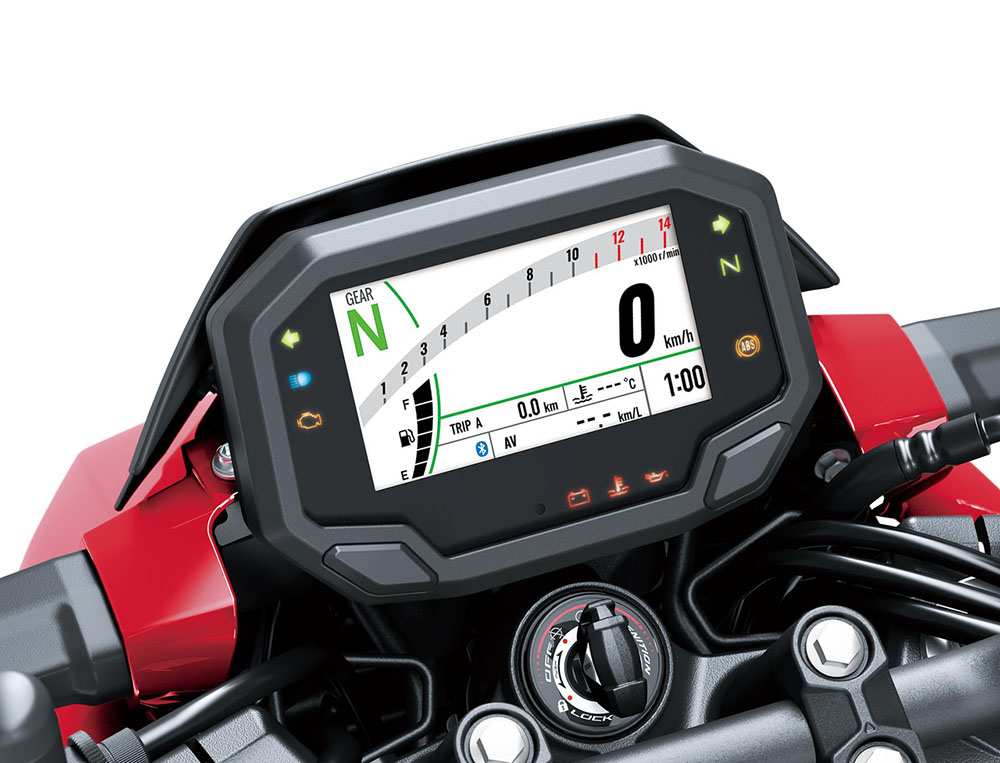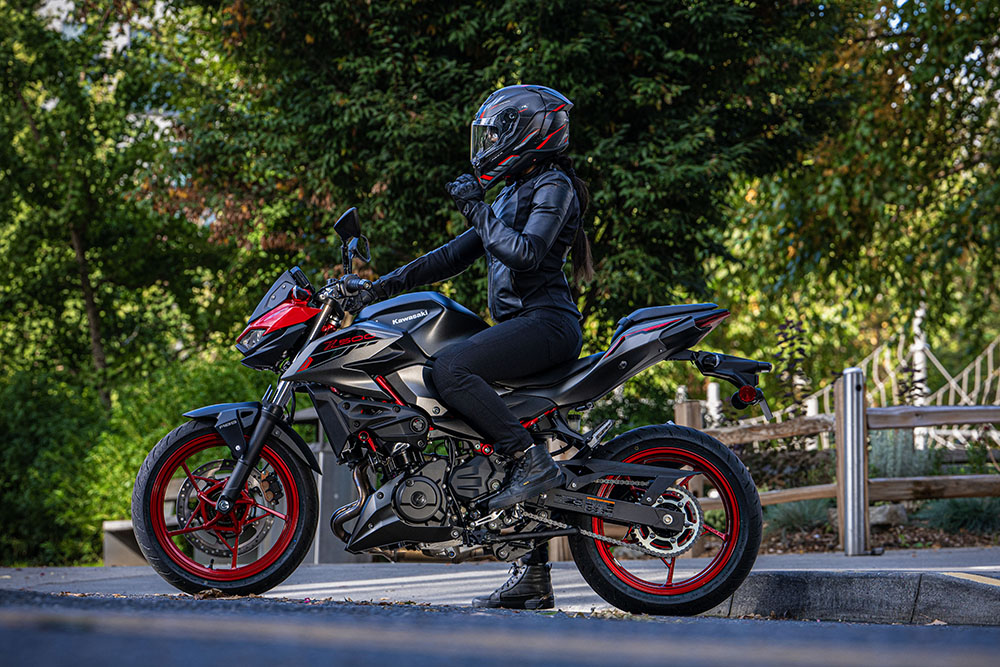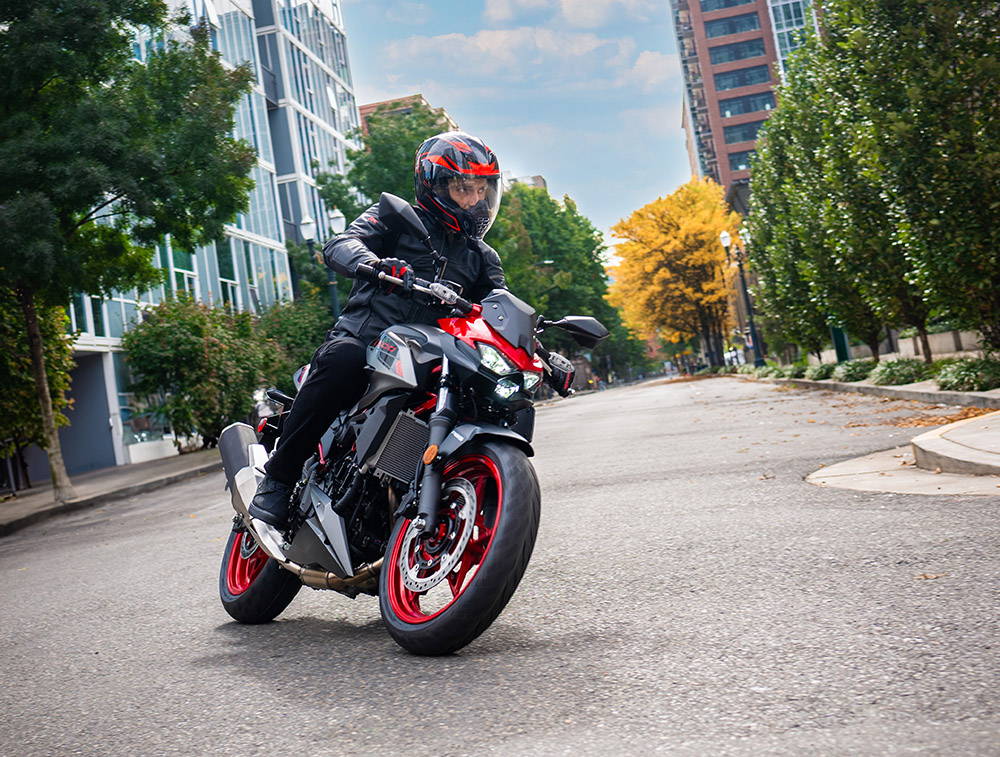Kawasaki’s 400cc parallel twin range has done well in recent years. Spanning a spectrum which sees it encompass everything from riding school favourite to world championship winning race machine, the Z400 and Ninja 400 have been good sellers for the green brand.
Despite the success, the 400s haven’t quite been able to match the showroom sales of Honda’s ginormous 500 range, which have really captured the imagination of the A2 buying public. With competitive prices, performance right on the category limit and a style for every taste, the Hondas have provided the benchmark in the sub-500cc category. Kawasaki’s new-for-2024 range is looking to break that domination, but how do they fare in reality?
With the exception of the cruiser style Eliminator model, Kawasaki’s 500s are not, as bike marketeers often like to say, ‘all new’ but they are significantly upgraded. The names are new, by virtue of a bigger capacity engine, which gets a 52cc hike to 451cc thanks to a 7mm longer stroke. The new motor gives a tiny bit more power, less than half-a-horsepower on top of the outgoing 400 to take it to just under 45bhp, but there’s a decent gain in torque – up by 5.6Nm to 42.6Nm, and that comes a little lower in the rev range too. 450 would probably be a more accurate name for the updated Kawasakis, but no-one can blame them for rounding things up. The A2 class is stacked full of a diverse range of models, so what’s 49cc between friends! It’s worth noting that the Honda is not a ‘true’ 500 either, being 471cc, so in reality there’s only 20cc difference between the offerings of the two manufacturers.

We’re riding the Z500, the naked variant which goes up against Honda’s revitalised Hornet 500 in sporty-streetfighter sub-sector. Other bikes in the class include KTM’s Duke 390, which has also been updated for 2024, and the Yamaha MT-03. They’re the most mainstream offerings in the category and all have faired, pseudo sporting, siblings designed to appeal to a slightly different audience for a small price premium (while remaining mechanically identical under the bodywork). In Kawasaki’s case, the Ninja 500 is the faired alternative. The only real differences between it and the Z500 we’re riding are the racy ZX-10R style bodywork, the slightly more sporting ergonomics and the price, which is £300 more expensive.
One thing Kawasaki have been particularly good at doing is giving their smaller capacity models real presence. The Z500 continues this trend and from most angles has the look of a much bigger and more expensive bike at first glance. It’s only when you look at the bike from the rider’s left hand side that you’ll notice the budget single front disc brake set-up, while the ‘Z500’ badging on the sidepods truly give the game away. It’s a well proportioned machine, and looks like it belongs alongside the likes of the Z650 and Z1000 in Kawasaki’s range.
The first impression of the Z500 is just how light it is. The official kerb weight (ie with fuel and oil) is 172kg but I could have sworn it felt like less as I wheeled it out of Kawasaki’s UK HQ and into the back of my van. Surely they’d given it to me without petrol? No, kindly, they’d brimmed the 14 litre tank – it really is that light! Climb on board and it feels like one of the more premium 125s on the market at standstill. It’s not spindly or unsubstantial, but is very accessible with the narrow saddle (and 785mm seat height) making it easy for most riders to get on with.
Start it up and the ease continues. The clutch action is absurdly light and the gearbox positive. It really is an excellent city bike, thanks in no small part to its lightness and upright riding position. If anything, it’s a good bit easier to ride at slow speeds than a 125 as the extra torque makes pulling away a doddle. This is one of the most confidence inspiring bikes I’ve ever ridden when it comes to doing manoeuvres like turns in the road, and it’s easy to see why the outgoing 400 was so popular with riding schools.
Hit the open road and you start to feel the lack of capacity, even though these A2 bikes have more than enough performance for the real world. It’ll easily sit at motorway speeds, and I would wager there’s a three figure top speed in there somewhere. Where these smaller bikes ‘lack’ is relative refinement at cruising speeds. They need to be thrashed to get the most out of them, which can make the engine feel very buzzy. Get above 6000rpm and the high frequency vibrations can be rather annoying, distorting the view in the otherwise excellent mirrors and being quite uncomfortable through all the touch points. That said, I found sitting further back in the saddle helped a lot, and I held a lighter grip than I maybe normally would. Thankfully 70mph in top equates to just below the buzzer zone – meaning it’s possible to sit on the motorway in relative comfort. This is not a criticism aimed solely at the Kawasaki it has to be said, as every ‘small’ twin I’ve ridden, including the Honda 500s and Yamaha’s MT-03, suffer in some way. Kawasaki do make a 30mm taller saddle, which is presumably more padded, and it’s an accessory I’d like to try out to see if it dampens some of the vibes. Bigger capacity machines, even Kawasaki’s own 200cc larger Z650, are much more relaxed in these conditions and do bring more comfort. That would be one of my main reasons to consider a bigger machine, if budget and licence allow it.

That said, I had no complaints about the Z500’s saddle comfort and that engine just loves to be revved. Even though the longer stroke motor delivers its performance lower in the rev range than the 400 which went before, it still begs to be thrashed. Combined with the lightweight chassis, it is a lot of fun on the back roads. Kudos too to what Kawasaki calls it’s ‘assist and slipper’ clutch. It works really well, basically smoothing out any sloppy downshifts through the gearbox and avoiding locking up of the back wheel. You don’t notice it at all, which is probably the best complement I can give.
Z is the name Kawasaki gives to all its roadster models and (with the exception of the more classically styled ‘RS’ derivatives) they’ve got an aggressive family face to them, which is shared with the 500. I like it. I think it’s got something about it and hits a nice balance, being more distinctive than the Hornet, not as in your face as the KTM and less out there than the Yamaha. It’s a motorcycle with broad appeal, and not just to novice riders. Anyone looking for a simple, accessible and less expensive motorcycle shouldn’t be put off by the ‘A2’ tag.
Fit and finish is in line with what you’d expect for an A2 category machine. Some of the componentry is a bit budget, witness the old fashioned right way up forks, spindly handlebars, simple rear shock and single disc brake up front, but it also has to be noted that the specifications, as well as the fit and finish have all improved massively across this class in the decade it has existed. Compared to the last Kawasaki 400 I rode, probably six years ago, it feels like a much more upmarket product. Not only does that TFT dashboard make the rider’s view feel much more premium, but the general quality is a notch or three higher. The paint is of high quality, the tyres better specced (Japanese made Dunlops, compared to rock hard Chinese CSTs on the last one I rode) and the overall finish very good. Things you might forgive a budget naked bike for, like unsightly hoses and cabling, are very much at a minimum and overall I found the saddle of the Z500 a very nice place to be. It’s a bike aimed at younger riders, and although it maybe doesn’t have as many fancy gizmos and gadgets as some bikes in the category, it feels fresh and youthful enough to appeal to its target audience. By the way, the TFT dash on our SE test bike is very good. It’s clean and easy to read, and flashes when the rider needs to change up a gear. The switchgear too, is very easy to use.

Despite lacking some of the capacity of the Hondas, the old 400s never really felt like they were giving away much in terms of performance in the A2 stakes, although they certainly needed to be worked a little harder to unlock it. Without riding old and new back-to-back, and without having a Honda for direct comparison, it’s hard to definitively say which is best. It’s been quite a few years since I last rode the Kawasaki Z400 but the gut feeling is that the new model is more relaxed to ride than its predecessor, being less revvy and meatier in the mid-range. It does still feel more playful than the Hondas I’ve ridden recently, I think down to the lightness of the overall package as well as the engine characteristics.
Colours are plain black (with grey and green graphics) for the base model, or classic Kawasaki combos of green and black, or red and black on the more upmarket SE version we tested. The SE versions have coloured frames and wheels and do a good job of not being too in your face despite using some pretty strong colours.
Sure, it’s been built to a price and there’s no shame in that, but I’d say Kawasaki are doing as good a job as, if not better than, their key competitors when it comes how well finished it is. You get a lot for your money with the Z500 and it’s very competitively priced against its main rival, undercutting the £6199 Hornet 500 by a not insignificant amount.
There are two versions of the Z500 (and the Ninja too). We rode the SE variant which, at £6049, costs £350 more than the base model. For that you get the more upmarket two-tone livery, the aforementioned colour TFT dash (with smartphone connectivity) and a USB-C charging point. Other SE spec upgrades include the radiator guard and bellypan. The Ninja SE also gets Kawasaki’s keyless ignition system, but this is omitted from the naked Z.

That said, it does lag slightly behind the Hornet on the spec sheet. There are no rider modes or electronics to speak of, and the power is slightly down. The Honda also has a twin front brake set up, which is more than you’d expect in the class. To be honest, although the Z500’s single disc arrangement is more than adequate, I would quite like to have seen a second disc up front for the aesthetic. Now I appreciate that this adds weight and cost, and is largely unnecessary, but I just think seeing that exposed wheel emphasises the Z500’s small capacity. That said, the 310mm disc is as big as you’d find on 1000cc supernaked, performs well and looks great from that side of the bike.
Conclusion
There’s a strong demand for well built A2 licence bikes these days and Kawasaki’s Z500 is a worthy contender. If I’ve got one concern, and it really is only one, then I just wonder if it’s distinctive enough to carve out a niche in this highly competitive sector. At one end of the scale you’ve got characterful retros like the offerings from Royal Enfield and Triumph’s new 400s, while at the other there are the smaller but sportier and more tech laden bikes from KTM and Yamaha. The Kawasakis sit in the middle, along with Honda’s 500 range, and they are all very, very competent. It’ll continue to do great business with riding schools and commuters looking for a cheap set of wheels but it would be a shame if that’s all the Z500 is deemed to be, because it really is good fun and feels bigger and more grown up than some of the more glamourous models in the sector.
The capacity hike has made for a bike that’s easier to ride than the older 400 model and, with a good spec (especially on the SE model) and sharp pricing, it deserves consideration from anyone looking for an A2 motorcycle.

2024 Kawasaki Z500 specification
Price: From £5,699
Engine: 451cc parallel-twin, four valves per cylinder, liquid cooled
Power: 44.8bhp (33.4kW) @ 9,000rpm
Torque: 42.6Nm @ 7,500rpm
Transmission: Six-speed, chain final drive
Frame: High tensile steel trellis frame
Front suspension: 41mm telescopic forks, 120mm travel
Rear suspension: Single shock absorber with adjustable preload, 130mm travel
Wheels: Cast aluminium five spoke alloy
Tyres: (F) 110/70 x 17, (R) 150/60 x 17
Brakes: (F) Single semi-floating 310 mm single disc. Two piston caliper (R) 220mm disc, two piston caliper. ABS equipped.
Weight: 172kg (kerb)
Wheelbase: 1,375mm
Seat height: 785mm
Fuel tank: 14 litres
Service intervals: 7,600 miles/12 months
Warranty: 24 months unlimited mileage
Contact: www.kawasaki.co.uk



